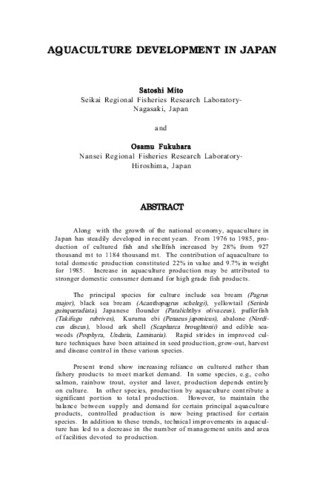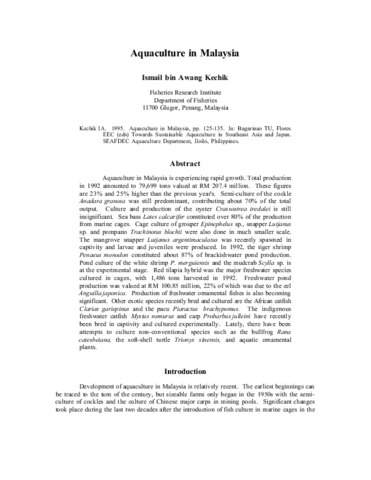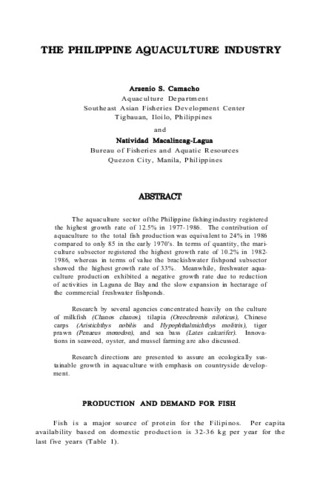Aquaculture development in Japan
- Global styles
- MLA
- Vancouver
- Elsevier - Harvard
- APA
- Help

Date
1988Author
Page views
7,356ASFA keyword
seed (aquaculture) 
feeding
shrimp culture
shellfish culture
feeds
disease control
mollusc culture
seed production
prawn culture
cultured organisms
aquaculture
aquaculture economics
rearing techniques
aquaculture enterprises
fish diseases
aquaculture development
breeding
fish consumption
seaweed culture
breeding stock
harvesting
aquaculture techniques
biotechnology

feeding

shrimp culture

shellfish culture

feeds

disease control

mollusc culture

seed production

prawn culture

cultured organisms

aquaculture

aquaculture economics

rearing techniques

aquaculture enterprises

fish diseases

aquaculture development

breeding

fish consumption

seaweed culture

breeding stock

harvesting

aquaculture techniques

biotechnology

AGROVOC keyword
Taxonomic term
Metadata
Show full item record
Share
Abstract
Along with the growth of the national economy, aquaculture in Japan has steadily developed in recent years. From 1976 to 1985, production of cultured fish and shellfish increased by 28% from 927 thousand mt to 1184 thousand mt. The contribution of aquaculture to total domestic production constituted 22% in value and 9.7% in weight for 1985. Increase in aquaculture production may be attributed to stronger domestic consumer demand for high grade fish products.
The principal species for culture include sea bream (Pagrus major), black sea bream (Acanthopagrus schelegi), yellowtail (Seriola guinqueradiata), Japanese flounder (Paralichthys olivaceus), pufferfish (Takifugu rubrives), Kuruma ebi (Penaeus japonicus), abalone (Nordicus discus), blood ark shell (Scapharca broughtonii) and edible seaweeds (Porphyra, Undaria, Laminaria). Rapid strides in improved culture techniques have been attained in seed production, grow-out, harvest and disease control in these various species.
Present trend show increasing reliance on cultured rather than fishery products to meet market demand. In some species, e.g., coho salmon, rainbow trout, oyster and laver, production depends entirely on culture. In other species, production by aquaculture contribute a significant portion to total production. However, to maintain the balance between supply and demand for certain principal aquaculture products, controlled production is now being practised for certain species. In addition to these trends, technical improvements in aquaculture has led to a decrease in the number of management units and area of facilities devoted to production.
In the future, greater efforts will be directed to diversify the species cultured to suit consumer preference. Emphasis will also be placed on improving taste and texture of cultured products. New types of feed that will not pollute areas around the culture facilities will be developed. Remarkable achievements in biotechnology will also be applied in aquaculture to improve seed quality.
Parallel with developments in aquaculture, Japan is exerting greater efforts to propagate fishery resources in coastal waters through stock enhancement activities. This is aimed at establishing a multiple fish and shellfish propagation system in the seas surrounding Japan to maintain or increase production from fishery resources.
Suggested Citation
Mito, S. (1988). Aquaculture development in Japan. In J. V. Juario & L. V. Benitez (Eds.), Perspectives in Aquaculture Development in Southeast Asia and Japan: Contributions of the SEAFDEC Aquaculture Department. Proceedings of the Seminar on Aquaculture Development in Southeast Asia, 8-12 September 1987, Iloilo City, Philippines. (pp. 39-72). Tigbauan, Iloilo, Philippines: SEAFDEC, Aquaculture Department.
Type
Conference paperISBN
971851113XCollections
- ADSEA '87 [20]
Related items
Showing items related by title, author, creator and subject.
-
Aquaculture in Malaysia
Kechik, Ismail bin Awang. (Aquaculture Department, Southeast Asian Fisheries Development Center, 1995)Aquaculture in Malaysia is experiencing rapid growth. Total production in 1992 amounted to 79,699 tons valued at RM 207.4 million. These figures are 23% and 25% higher than the previous year's. Semi-culture of the cockle ... -
Aquaculture development in Thailand
Sirikul, Boonsong; Luanprida, Somsak; Chaiyakam, Kanit; Sriprasert, Revadee (Aquaculture Department, Southeast Asian Fisheries Development Center, 1988)Aquaculture practised in Thailand is in the form of pond culture and cage culture in freshwater, brackishwater and coastal areas. The main species cultured include freshwater prawns, brackishwater shrimp, cockles, mussels, ... -
The Philippine aquaculture industry
Camacho, Arsenio S.; Macalincag-Lagua, Natividad (Aquaculture Department, Southeast Asian Fisheries Development Center, 1988)The aquaculture sector of the Philippine fishing industry registered the highest growth rate of 12.5% in 1977-1986. The contribution of aquaculture to the total fish production was equivalent to 24% in 1986 compared to ...





